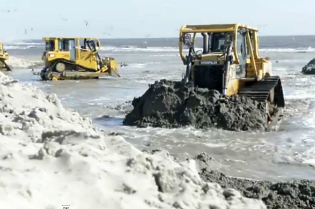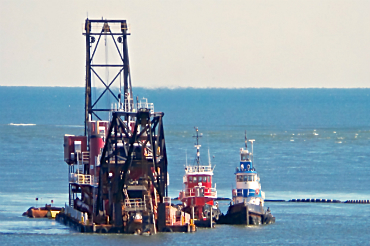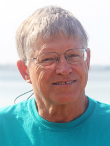The state Division of Coastal Management will submit for public comment Tuesday a series of proposals to change the way inlets are managed, including expanding the time “window” for dredging and beach re-nourishment into sea turtle and bird nesting seasons.
The idea is part of an overall inlet-management study by the division and its policy-making Coastal Resources Commission, and thus far has drawn relatively little public debate.
Supporter Spotlight
 Proponents say that lengthening the time that beach re-nourishment projects can be permitted will save beach towns millions of dollars on each project. Photo: Army Corps of Engineers Proponents say that lengthening the time that beach re-nourishment projects can be permitted will save beach towns millions of dollars on each project. Photo: Army Corps of Engineers |
Current state policy requires projects that dredge inlets and re-nourish beaches to be done in the winter, from Dec. 1 through March 31, to minimize the effects on sea turtles and birds. Proponents say that widening that window would reduce costs, but a host of state and federal agencies are concerned and watching the process very carefully.
“It depends on how big of an expansion they propose and where it would apply,” said Kathy Matthews of the U.S. Fish and Wildlife Service office in Raleigh. “It could have significant impacts on sea turtles, shorebirds and wading birds. Right now, we recommend that these activities don’t take place after March 31, and there are good reasons for that.”
Birds start appearing on the state’s beaches in greater number after that date, she said. The service, she noted, is particularly worried about species on the federal endangered species list, such as the piping plover, which nests on beaches in the state. The red knot is another species that uses the beach in warmer weather. The service has proposed putting it on the list.
Allowing dredging and beach projects in April would be less of a problem for nesting sea turtles, Matthews said. Turtles would be more threatened by later projects, she said. The federally protected animals nest along oceanfront beaches, usually starting in mid-May and continuing through the summer and early fall.
Matthew Godfrey, who heads up the state’s turtle program at the N.C. Wildlife Resources Commission, agreed. Although the feds generally make the crucial recommendations on whether the Army Corps of Engineers should issue the permits for dredging and re-nourishment projects, he said, “We collaborate and consult and back up their decisions. There is a potential for problems with turtles” in the spring.
Supporter Spotlight
One of the chief proponents of changing the window is Greg “Rudi” Rudolph, head of the Shore Protection Office for Carteret County.
“We obviously don’t want to do anything to harm turtles or birds, but we think we can expand this window some without doing that,” he said. “We already deal with endangered and threatened species in projects, and we would just take additional steps to make sure that dredging and nourishment activities (in an expanded window) wouldn’t cause problems.”
For example, Rudolph said, observers watch for turtles during dredging projects and a trawler intercepts any turtles that get too close to the dredge. Expanding the window into a time of warmer water and more turtles would require more monitoring and perhaps more interceptions, Rudolph said, but it would be worth it economically.
A re-nourishment project in Virginia Beach near the end of the summer cost $5.50 a cubic yard of dredged sand, he explained. The Atlantic Beach project last winter cost $12 a cubic yard, Rudolph noted. “You can see that you’re talking about millions of dollars in savings, per project,” he said.
 Forcing dredging projects to be done just in the winter increases the demand on the few dredges capable of doing the work, some say, thus forcing up the price. Photo: Dredging Today Forcing dredging projects to be done just in the winter increases the demand on the few dredges capable of doing the work, some say, thus forcing up the price. Photo: Dredging Today |
Rudolph conceded that there is some degree of mystery to costs. “It’s kind of like gas prices at the pump,” he said. “There are a lot of variables, and sometimes it’s hard to see why it goes up or down. But one thing you can be sure of is that supply and demand play a big role.”
Few companies do that kind of work, Rudolph explained, and the number of projects is increasing. Forcing the work to be done in several winter months guarantees higher costs, he said. Then, Rudolph said, you have to factor in that fewer and fewer federal dollars are available for dredging and re-nourishment. That means local governments – with state aid – these days have to pick up more, if not all, of the cost.
Rudolph said the current policy isn’t etched in stone, anyway. Projects can and do get exceptions, he noted, and have to work with tougher conditions, such as more monitors and area restrictions.
“I think the Coastal Resources Commission is sympathetic to the plight of project sponsors and is going to work hard to find a workable solution,” Rudolph said.
Discussions about an inlet-management plan began in December, when Frank Gorham, the Coastal Resource Commission chairman, proposed the measure in response to a study on redrawing regulatory boundaries at the mouth of the Cape Fear River. Instead of examining that one site, the commission directed staff members to conduct a management study for all 12 of the state’s developed inlets. The Division of Coastal Management held public hearings throughout the state, collecting comments on potential inlet-management practices. Staff members presented those comments to the commission in May. Commissioners finally compiled a list of 10 priorities, including standards for beach fill material, funding sources and dredging windows.
Charles “Pete” Peterson, a researcher at the UNC Institute of Marine Sciences in Morehead City, like Rudolph, is a member of the commission’s panel of scientific advisers. The Science Panel has not been asked to discuss the idea of expanding the dredging and re-nourishment window. Peterson has long been a strong advocate for very high standards for beach re-nourishment after he studied the dramatic declines in invertebrate populations – mole crabs, coquina clams and the like – on beaches where extremely fine sand was used. He said the whole concept of expanding the window is somewhat disingenuous.
 Charles “Pete” Peterson |
“Hell, what window?” he said. “It’s already been expanded about as much as it can be,” at least informally, he said. “Every recent project in Dare County has been outside the ‘window.’”
Mickey Sugg of the regulatory section at the Wilmington District Office of the Army Corps of Engineers said there is some flexibility already, and the Corps essentially “negotiates” between those who propose projects and the agencies charged with the responsibility to protect threatened and endangered turtles and birds.
The Corps circulates permit applications to the environmental and protection agencies, which offer comments. If the project raises questions, the Corps consults with the applicant. The goal is to find a project time, plan and protective measures that can satisfy everyone, Sugg said.
For example, he said, increased beach monitoring might address the issue, with more observers required to look for nests and the markings in the sand that indicate a turtle has come ashore to nest.
“Our job is to try to strike a balance,” Sugg said. But he added that the Corps and the other agencies generally are “comfortable” with the current window.
“We’re obviously not proponents or opponents of any project or necessarily of changing the window,” he said. “We look to the agencies for the expertise.”
The major federal agency involved in turtle protection is the National Oceanic and Atmospheric Administration’s protected species section. Dennis Klemm, sea turtle program coordinator for NOAA’s southeast regional office in St. Petersburg, Fla., said the agency is working on a new regional biological opinion for the issue. It would cover everything from the North Carolina-Virginia border to Key West, Fla.
Ryan Hendren, a contract employee working on the project in Klemm’s office, said it’s a very complicated issue that involves looking at federally approved dredging and re-nourishment projects at more than 50 sites. Each of those has unique characteristics, based on geography and the different threatened and endangered species known to be there at different times. In some locations, for example, it’s not just turtles that cause concern but whales.
“We have to look at a lot of different projects from a lot of different angles,” he said. “It’s a large geographical area, with a wide range of projects and a wide range of potential impacts. We’re currently putting it together by project.”
In the end, though, the regional biological opinion will be the primary factor that guides the Corps’ decisions on permits.
Hendren said the goal is to have the new opinion finished by the end of the year, but that delays are possible. He and Klemm both said the discussion is an important one, an attempt to balance the critical protection of the species with the states’ desires for more flexibility in the timing of projects.
 A female loggerhead sea turtle draws a crowd at Carolina Beach. Wildlife officials fear that extending beach and dredging projects beyond the winter could adversely affect nesting turtles. Photo: Carolina Beach A female loggerhead sea turtle draws a crowd at Carolina Beach. Wildlife officials fear that extending beach and dredging projects beyond the winter could adversely affect nesting turtles. Photo: Carolina Beach |
The primary governing law is the federal Endangered Species Act, which prohibits killing or harassing listed animals and prevents federal agencies from allowing actions that would harm the animals or their habitats. While that appears to be pretty rigorous protection, the reality is that various amendments over the years have lessened the law’s effects. The Fish & Wildlife Service, for instance, can issue “incidental take permits” if harming or killing a species is merely incidental to an otherwise lawful activity and if the permit applicant has devised an acceptable habitat conservation plan. Almost all beach and dredging projects receive such permits.
Matthews said that in the spring, especially, beach activities can also easily run afoul of the less-discussed Migratory Bird Treaty Act, which affects the United States, Mexico, Canada and Russia. The act makes it illegal for anyone to take, possess, import, export, transport, sell, purchase or barter any migratory bird or the parts, nests or eggs of such a bird except under the terms of a valid permit issued pursuant to federal regulations.
There are more than 1,000 birds in the U.S. covered by the act, Matthews said, “and we can’t even write a permit for a take. If a bird is an endangered species, we can write a biological opinion and allow some incidental takes. But if a bird covered under the MBTA is impacted – say you crush some eggs or kill an adult or a chick – there can be serious repercussions,” including fines of up to $15,000.
And a number of shorebirds in North Carolina are not endangered but are covered by that law. Many are common in the spring and summer, such as oyster catchers, ibises, terns and willets.
“We’ve not really been involved in these discussions yet, but we will be,” Matthews said. “This year, even within the existing window, we had some problems with some projects. And if you allow more activities in April and May, the potential is certainly there for more problems.”
Andy Wood, a respected ornithologist, longtime staffer for Audubon North Carolina and head of the Coastal Plain Conservation Group, based in Hampstead, said he would be concerned about all of those birds if the window expands.
Like Matthews, he said the time before nesting actually begins is also crucial for the birds as they are “scouting” potential sites and beginning “breeding behavior,” activities designed to attract and prepare for mates and mating. If these activities are disrupted or discouraged, mating might not occur, there or elsewhere. And birds are already under a lot of pressure because of shrinking habitat, climate changes and changes in food supplies.
He’d be particularly worried about the effects on the plovers, including piping and Wilson’s, as well as red knots and oyster catchers and ibises, even herons and egrets.
 Andy Wood |
“What they’re talking about is expanding this window into what is already a very challenging time of year for a lot of birds,” he said. “It could have a big impact at certain times and in certain places.”
Some are also concerned about the potential impacts on fish. Matthews, for example, noted that nourishment can bury the tiny coquina clams and mole crabs that make up a big portion of the food supply for some surf fish. Extending that potentially harmful activity later into spring could have impacts on stocks.
Peterson, in fact, said he and two other researchers, Lisa M. Manning, a biologist with the NOAA/National Marine Fisheries Service Office of Protected Resources in Silver Spring, Md., and Melanie J. Bishop of Macquarie University in New South Wales, Australia, just published a study that indicates April and May might just be the absolute worst time to put dredged sand on beaches.
They concluded that “beach nourishment projects utilizing fine sediments from dredge spoil have significant negative ecological impacts. The spring-time depositions of unnaturally fine sediments depressed normally abundant invertebrate populations for the entire warm season. After winter low abundances on disposal sites and control beaches, the next annual disposal event acted again to suppress warm-season … abundances, thereby generating a cumulative impact from successive annual disposal events.”
What this means, Peterson said, is that there was significantly less food available for fish in the surf zone, especially Florida pompano, king fish and sea mullet, but also, to a somewhat lesser extent, early life-stage flounder and even drum.
And, he said in the report, the nourishment really didn’t do much good.
“The disappearance of virtually all the added volume of dredge spoils from the beach within a year implies that any protection it provides against storm damage dissipates rapidly,” the report states. “Coastal resource management should compare benefits of beach augmentation (i.e. helping to protect beachfront property against storm damage), against the ecological costs of annually repeated spoil disposals indefinitely suppressing invertebrate prey densities.”
Instead of placing that material from maintenance dredging of navigation channels on the sandy beach, the report suggests that the material could be used elsewhere on barrier islands.
“Specifically, the total area of islands in major bays and sounds has diminished greatly as sea levels have risen over the past few decades,” the report states. “Fine sediments from maintenance dredging can be used to elevate now inundated sections of those islands and restore habitat for wetlands that can serve to expand limited roosting, nesting and foraging areas of water birds and habitat for terrapins.”
All of this, the report states, is happening as pressure mounts for more and more beach nourishment.
“As rising sea levels and an increasing frequency of violent storms from global climate change enhance risk of storm damage to oceanfront property, public support for beach nourishment appears to be growing,” the report states.
The Coastal Resource Commission’s next meeting is set for Oct. 22-23 in Wilmington.








